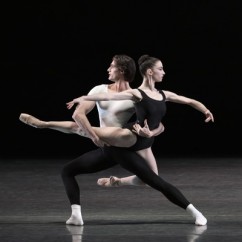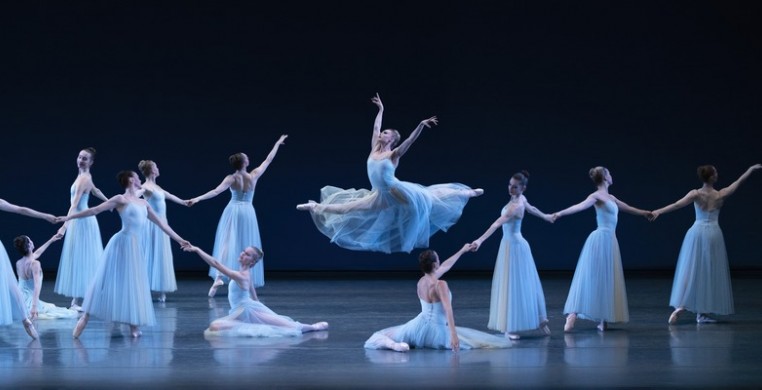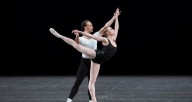The ancient philosopher Plato surmised that there was an alternate world of perfect forms, examples from which we draw our knowledge of the natural world. Is such a thing possible in the world of ballet? Yes!
After experiencing “Masters at Work: Balanchine + Robbins,” it’s easy to see why the New York City Ballet (NYCB) is often held as the gold standard of American ballet. On March 21 & 23, NYCB stayed true to their historic roots by presenting three works by founding choreographers George Balanchine and Jerome Robbins at the Harris Theater. With the company celebrating their 75th anniversary, it is only fitting that they go back to where it all began.
We are reminded why Balanchine is considered a cornerstone of U.S. contemporary ballet with the presentation of “Serenade” (1935), the artist’s first original ballet created in America. The four movements—“Sonatina,” “Waltz,” “Russian Dance,” and “Elegy”—dazzle as large corps of dancers form into geometric shapes, dissolve into pandemonium and recombine in intricately timed formations. The jaunty yet somber score by Tchaikovsky is augmented by brilliant, white flowing skirts by costume designer Karinska that absorb and conform to the colorful lighting by designer Mark Stanly.
In “Elegy,” dancers Sara Mearns, Miriam Miller and Erica Pereira shine as three goddesses, hair unbound, who fly, flip and turn on the edge of life and death. Accompanied by dancers Aarón Sanz and Taylor Stanley, the women exhibit joie de vivre through perfectly balanced promenades and fast-paced partnering. As one is lifted high into the air, it becomes apparent that not all will survive.
It’s clear that NYCB keeps this seminal work in top shape. When the entire ensemble is on stage, the height of ever raised leg and outstretched arm are near identical, their timing of rhythms synchronous. You could take a snapshot of any moment and it would appear as a posed photograph. For Chicago audiences who may not have seen a work by Balanchine before, this was a superb introduction.
 Balanchine's "The Four Temperments," with Alexa Maxwell and Aarón Sanz; Photo by Erin Baiano
Balanchine's "The Four Temperments," with Alexa Maxwell and Aarón Sanz; Photo by Erin Baiano
“In the Night” (1970) by Robbins is a series of four traditional pas de deux performed by Indiana Woodward and Alec Knight, Emilie Gerrity and Tyler Angle and Unity Phelan and Andrew Veyette, set to selections from Chopin’s “Nocturnes.”
Robbins’ musicality is on full display, with movements that accurately match the delayed accents and unexpected sustain of musical notes for which the composer is known. A trill on the piano elicits the flutter of a foot as one of the ballerina are suspended upside down. A sweeping crescendo across the length of the keyboard inspires another woman to be launched into the air, inverted, spun around and sent sliding through her partner’s legs as she returns to ground. It’s like you are seeing the music literally transmuted into movement.
A study on theme and variation is presented in Balanchine’s “The Four Temperaments” (1946) to music composed for the work by Paul Hindemith, featuring soloist Stephen Gosling on the piano. The company of dancers are split up into smaller groups, each representing a different disposition—melancholic, sanguinic, phlegmatic and choleric. Each variation transforms the themes presented at the top of the work, delving into increasingly darker territory.
A movement theme that persists throughout the work is that of outstretched arms, like sinners making an appeal to heaven before death. High-arched fan kicks, deep lunges, spinning jumps… all are oriented to the sky, asking, “Why?” Despite the moody atmosphere the dancing can be jubilant, as when a string of ballerinas with beveled legs form a line, then prance on pointe to the trill of pizzicato rhythms played on violins—a dash of playfulness. But something sinister is inherent in the work, which culminates in a gang of dancers threatening a lone ballerina in the center of a circle by leaning in closer and closer until she might be smothered! In "The Four Temperments," Balanchine expertly merges beauty and tragedy, a reflection on the human condition.
Chicago is no slouch when it comes to ballet, but there’s something special about seeing the works of Balanchine and Robbins performed by the company they helped form. When it comes to imagining American ballet in its most perfect form, NYCB’s “Masters at Work” is about as close to it as one can get.


